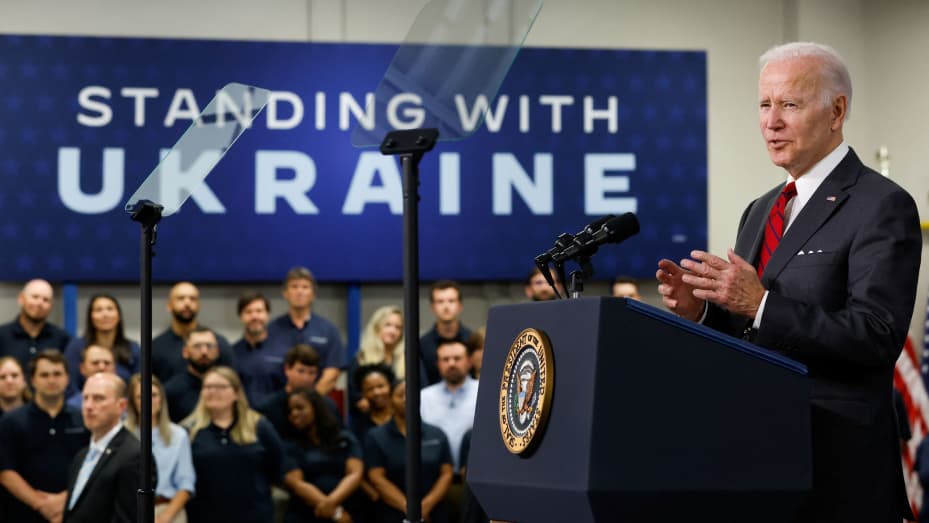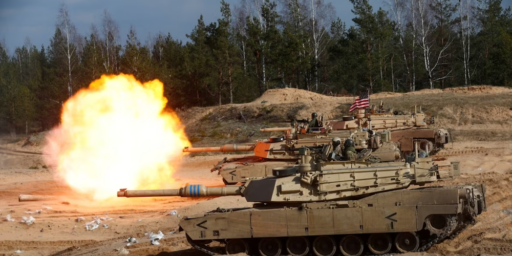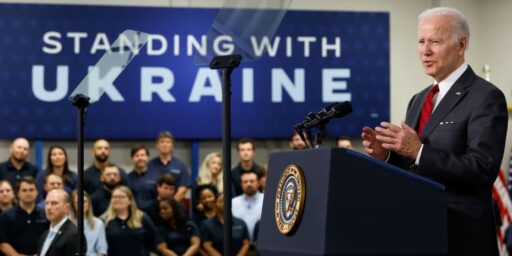America’s Slow Escalation in Ukraine
The Biden administration is slowly ratcheting up the aid package.

WaPo (“U.S. readies another massive military package for Ukraine“):
The Biden administration is preparing to announce a roughly $2.5 billion military aid package for Ukraine that is expected to include dozens of Bradley and Stryker armored vehicles, according to two people familiar with the decision, as the Pentagon intensifies its support ahead of an expected counteroffensive against entrenched Russian forces.
The war has entered a phase, U.S. officials have said, that will require Ukrainian units to attack enemy forces in a concerted way, using tanks, armored vehicles, artillery and aviation in what is known as combined arms warfare. Bradleys and Strykers would significantly bolster their firepower and allow soldiers to move quickly around the battlefield.
The coming transfer could contain nearly 100 Strykers, one of these people said. It would mark the first time the Pentagon has supplied Ukraine with such vehicles. Those familiar with the plan spoke on the condition of anonymity to discuss it ahead of a formal announcement.
The Bradley fighting vehicles included in this transfer will be in addition to 50 vehicles announced earlier this month in a separate $3 billion arms package, the people said. The next tranche of aid also will include a substantial restock of ammunition for howitzers and rocket artillery, they said, and more mine-resistant vehicles.
The new vehicles are intended to complement the large-scale, combined arms training that several hundred Ukrainian soldiers are receiving at a U.S. military facility in Germany to help them change the dynamics of the battlefield, U.S. officials have said. As winter has taken hold, the fighting has concentrated in the south and east, degrading into a violent slugfest where both sides are suffering steep losses for modest gains.
“The Russians are really digging in. … They’re digging trenches, they’re putting in these dragon’s teeth, laying mines. They’re really trying to fortify that FLOT, that forward line of troops,” Undersecretary of Defense for Policy Colin Kahl told reporters at the Pentagon on Wednesday. “To enable the Ukrainians to break through given Russian defenses, the emphasis has been shifted to enabling them to combine fire and maneuver in a way that will prove to be more effective.”
It is unlikely, however, that this aid package will include one of Kyiv’s most impassioned requests: M1 Abrams main battle tanks. The administration has rejected those requests, pointing to the logistical and technical burdens of operating the systems and suggesting they could quickly become a hindrance for the Ukrainians.
“The Abrams tank is a very complicated piece of equipment. It’s expensive. It’s hard to train on. It has a jet engine. I think it’s about three gallons to the mile of jet fuel. It is not the easiest system to maintain,” Kahl said. “It may or may not be the right system, but we’ll continue to look at what makes make sense.”
NYT (“U.S. Warms to Helping Ukraine Target Crimea“) adds:
For years, the United States has insisted that Crimea is still part of Ukraine. Yet the Biden administration has held to a hard line since Russia’s invasion of Ukraine, refusing to provide Kyiv with the weapons it needs to target the Crimean Peninsula, which Russia has been using as a base for launching devastating strikes.
Now that line is starting to soften.
After months of discussions with Ukrainian officials, the Biden administration is finally starting to concede that Kyiv may need the power to strike the Russian sanctuary, even if such a move increases the risk of escalation, according to several U.S. officials who spoke on condition of anonymity to discuss the sensitive debate. Crimea, between the Black Sea and the Sea of Azov, is home to tens of thousands of dug-in Russian troops and numerous Russian military bases.
White House officials insist there is no change in position. Crimea, they say, belongs to Ukraine.
“We have said throughout the war that Crimea is Ukraine, and Ukraine has the right to defend themselves and their sovereign territory in their internationally recognized borders,” said Adrienne Watson, a spokeswoman for the National Security Council.
Privately, military and administration officials had questioned the utility of Ukraine focusing attacks on Crimea, arguing Kyiv’s military had better targets elsewhere on the battlefield.
But the Biden administration has come to believe that if the Ukrainian military can show Russia that its control of Crimea can be threatened, that would strengthen Kyiv’s position in any future negotiations. In addition, fears that the Kremlin would retaliate using a tactical nuclear weapon have dimmed, U.S. officials and experts said — though they cautioned that the risk remained.
The new thinking on Crimea — annexed illegally by Russia in 2014 — shows how far Biden administration officials have come from the start of the war, when they were wary of even acknowledging publicly that the United States was providing Stinger antiaircraft missiles for Ukrainian troops.
But over the course of the conflict, the United States and its NATO allies have been steadily loosening the handcuffs they put on themselves, moving from providing Javelins and Stingers to advanced missile systems, Patriot air defense systems, armored fighting vehicles and even some Western tanks to give Ukraine the capacity to strike against Russia’s onslaught.
Now, the Biden administration is considering what would be one of its boldest moves yet, helping Ukraine to attack the peninsula that President Vladimir V. Putin views as an integral part of his quest to restore past Russian glory.
American officials are discussing with their Ukrainian counterparts the use of American-supplied weapons, from HIMARS rocket systems to Bradley fighting vehicles, to possibly target Mr. Putin’s hard-fought control over a land bridge that functions as a critical supply route connecting Crimea to Russia via the Russian-occupied cities of Melitopol and Mariupol.
However, President Biden is not yet ready to give Ukraine the long-range missile systems that Kyiv would need to attack Russian installations on the peninsula.
While American support has been vital to Ukraine’s success, the administration’s hedging out of fear of escalation has also been a source of great frustration. The reluctance was understandable in the early stage of the war, when Ukraine’s resolve and ability to hold its own was anything but a sure bet. But we’ve long passed the point where Ukraine is both winning the war and yet taking needless casualties because it’s under-equipped.
I must confess to being befuddled by some of the choices. We’ve been supplying HIMARS rocket artillery—among our more advanced systems—for months but are just now acceding to sending infantry fighting vehicles?! I’m agnostic on supplying Abrams and will take the Pentagon’s word that it’s too hard to maintain and sustain—but the platform itself has been in operation since the early 1980s and is fielded by several Middle Eastern armies; you’d think the Ukrainians could figure it out.*
And, frankly, taking back Crimea is the only acceptable outcome at this point. The Russians have committed atrocity after atrocity; they simply must lose the war in humiliating fashion rather than being allowed to slink back to the status quo ante.
*UPDATE: I gather from David Axe and others that the engine is the issue. Unlike the other armored vehicles being supplied—and just about any other tank in the world—the Abrams operates on a multi-fuel system rather than pure diesel, which vastly complicates both maintenance and supply.






Will these moves prompt the rest of Europe to step it up and do even more? This crisis is at their doorstep, after all. Scholz’s goverment has said Germany would only send more advanced weaponry if the US does. Okay, so…?
After Ukraine’s glorious and explosive victory over Putin, we might discuss how it is neither fair nor sustainable for United States to be more invested in European security than Europeans. The EU alone has at least 100 million more residents than the US — let the decadent surrender monkeys do more to defend themselves (said as Europhile plotting how to live in Berlin half the year).
I think that the administration’s approach has been pretty smart. They have managed, little by little, to repeatedly cross Russia’s declared red lines without inviting a nuclear response (with all the concomitant escalatory risks).
Using limited nuclear strikes to stop their opponents from winning a conventional war – especially in cases when “Russia proper” is threatened, is part of Russia’s military doctrine. Obviously, no one should want to go there.
However, the boiling frog approach seems to be working quite well so far.
One could quibble over the tempo in which the administration keeps pushing Russia’s red lines back (which then turn out to be not so red after all), but the idea itself is not bad at all.
@DK: Euro fecklessness in their own security affairs has been a constant lament on this side of the Pond for as long as I can remember.
@drj: I can understand, for example, the reluctance to be seen as participating in the takeback of Crimea under that framing. But how would supplying HIMARS not cross a red line but supplying decades-old fighting vehicle technology trigger nuclear war?
@James Joyner:
It’s not the fighting vehicles but things like ATACMS and GLSDB, or even airplanes.
I think the Pentagon is sincere in maintaining that the M1 Abrams has too much of a logistical tail. Although they should deliver half a dozen or so to convince Germany to allow the supply of the Leopard 2 (in much greater numbers).
And I do think that the risk of escalation would have been much bigger had the US immediately started supplying HIMARS in February or March.
@drj:
It’s a bit more complicated than that.
None of the individual Euro countries have the scale to create armed forces that can be used for force projection. On an individual basis, they don’t have the logistical capabilities, the satellites, or simply the size for a decent expeditionary force. So territorial defense is more or less the only thing that they can do independently. They can’t use their armies as policy tools. So why invest in these armies if they are not directly threatened themselves?
The situation would be different, of course, if the Euros would manage to create something like an integrated European military, in which case they might not have the will, but at least would have the scale to create a military capable of independent force projection.
But who do you think sabotaged every attempt to create a more independent and integrated European military? That would be the US, because such a step would threaten their leading role in NATO (assisted by the Brits who preferred their “special relationship” with the US over having to listen to the French).
In short, European countries depending on US military protection suited the US just fine, because it was another lever of power. And the Euros were quite happy with the deal, too.
It’s only now that the rise of China has changed the calculus that the US is not so enthousiastic anymore about the previous arrangements. Not unreasonably so, of course, but the current situation is at least partly of the US’s own making.
No opinion on this, just speculation. In the past I’ve heard that the reason we never developed a successor to the Abrams was because tanks were obsolete. If this was really the Pentagon’s position, will the Ukraine war cause us to rethink that?
I am not a foreign policy expert by any stretch.
But I think it’s time to quit toying around and we should just finish Putin off.
He has clearly committed war crimes, and continues to do so.
Squash the bug.
Saw this just after I typed my previous comment.
https://www.europarl.europa.eu/news/en/press-room/20230113IPR66653/ukraine-war-meps-push-for-special-tribunal-to-punish-russian-crimes
@DK:
Some European countries are contributing more on a per capita basis than the US.
And total European aid commitments are greater than that of the US.
The problem is that total European available weapons and active production capacity is lower, due to hellish inefficiency of running 30 separate military establishments, procurement systems etc.
And the related lack of political incentives to get behind weapons procurement that gets spent in other countries. Imagine how balky Congress would be on military budgets if everything was being purchased from Canada.
That hardly mean nothing is being sent. For instance, Denmark is donating every last one of it’s CAESAR 155mm guns
The main problem in Europe is in Berlin, the sheer mulishness of Scholz and the “Niedersachsen Faction” of the SPD.
More on this in a bit (he threatened)
Ukraine can decide what it wants, but I think the price in lives lost and war materials greatly increases if they also try to get Crimea back. That said, I think it is probably worth attacking Crimea bases to destroy Russian supplies and troops. They are fungible.
Steve
The Abrams is not the only tank with a compatibility issue. The British Challengers’ guns have rifled barrels (vs smooth bore everyone else) so they use special ammunition.
@drj: I think it’s fair to say that we wanted it both ways: to have the Europeans pull their weight in military spending and also wanting to be the leader of the alliance. I think, though, that we were on board with the idea of European consolidation of defense efforts and in particular things like the NATO “Smart Defence” initiative. What we opposed was creating a redundant infrastructure in terms of various EU alternatives to NATO that would have come out of hide.
@charon:
The multi-fuel capability of the Abrams includes the ability to burn the same fuel as everyone else. The problem is that capability makes the fuel system more complex, it takes longer to train maintenance crews for the Abrams. Being able to maintain tanks used in combat is a big issue.
@James Joyner:
Because NATO is by definition US-led. Do you think, for instance, that Congress would ever be OK with a German or Polish SACEUR? Or a South-Korean commander of ROK/US Combined Forces Command, for that matter?
Power has its price. Doesn’t mean that the current situation is necessarily fair or desirable, but there are (or, at least, were) significant benefits as well.
@James Joyner: Not to mention that when the post-WWII relationships were being established, European nations had demonstrated what they were capable of when left to their own devices – two horrendous world wide wars in 25 years, both of which required massive intervention from the US in order to end. I’ve gotta believe that reality played at least a part in the decision on how to rebuild Europe’s military. And since a great deal of the money was going to come from us anyway, us setting up bases might have actually been the cheaper way to go and created a softer landing for the US military industrial complex.
Post-9/11 (and post-Iraq and post-Afghanistan) the rising generation of Democrats and Republicans have some different ideas than the post-WWII cohort –about US interventionism, US military adventurism, and how US national security and homeland defense ought to be handled.
It’s maybe not a given that our elected Congress will always agree that NATO should always operate as arranged in the 1950s — pending whatever happens with Putin.
Biden has done an amazing job so far. But yes, it’s time to get behind the liberation of Crimea. There are apparently more than 4,000 Strykers in service in the US Army. Checking our borders I don’t think a Canadian or Mexican invasion is likely, so I’m not sure why we can’t spare 1,000 Strykers rather than 100. Sevastopol would be a swell US air and naval base.
I cannot wrap my head around the fact that there are people in this country and in Europe who are hesitant. This is a fantastic, once-in-a-generation opportunity to cripple a dangerous competitor. This is a horror movie moment where the heroine should finish off the mad slasher, not scream and run away. Take Russia out of the great power game and we can turn our full attention to China.
@MarkedMan:
“…both of which required massive intervention from the US in order to end”
Definitely the case for WW2; highly arguable for WW1.
As for the reconstruction of the European militaries after WW2, very little money came from the US, by contrast to the economic assistance re. Marshall Plan
It’s often forgotten how large the European armed forces were back in the 1970’s.
In 1976 US forces in Central Theatre were 89,000 troops, 2,500 tanks, 260 aircraft.
By comparison Germany: 345,000 troops, 2,400 tanks, 160 aircraft.
The British Army of the Rhine, that is that portion of the British Army deployed in Germany, was around 80,000 men at its peak.
What happened was, after the collapse of the Soviet Union, European defense withered.
The Red Army had gone, and unlike the US Europeans had never maintained global-reach airlift and sealift, umpteen carrier battle groups and amphibious assault task forces, intercontinental bomber, ICBMs etc.
All the spend had gone on conventional theatre defence forces (apart from UK and France).
If Europe had moved to redirect the spend to global power, the US might hot have liked all the consequences. European attitudes to managing Middle Eastern affairs, for instance, would probably have been rather at odds with preferences in Washington.
Even where total spend has not dropped of a cliff, eg in UK, priorities and politics have damaged core strength.
IMO UK problem is army politics since the early 2000’s have meant the heavy mob has been neglected in favour of the Special Forces/light infantry/air mobile lobby.
UK now has only 225 odd MBT remaining in service, out of five hundred purchased.
Total number of Challenger 1 and 2 was at one time near a thousand.
Now the repairs/spares/maintenance side has so rotted, it’s apparently hard to keep a hundred actually in fully operational condition.
Given the number of anti-Zelenskyy memes my brother has sent me recently, it seems safe to assume that Russia is stepping up the propaganda campaign aimed at the American right.
I have fears that the Republican House is not going to go along with this aid to Ukraine, and think we need to quickly escalate what we are giving Ukraine while we can.
And maybe whittle down McCarthy’s majority… can Brasil be persuaded to ask for Santos to be extradited?
Tomorrow is the next Ramstein conference of some 50 countries supporting Ukraine.
And it looks like a lot of the rest of Europe is lining up to twist Germany’s arms there.
And less spoken of, except very quietly, to pressurise the “anti-escalation” faction in Washington, which appears to have Jake Sullivan’s ear. And some in Europe suspect quiet collusion between some there and in Berlin over the Abrams/Leopard logjam.
Today’s Tapa meeting, convened by Estonia and the UK, had 11 countries attending. Pledged additional aid summarised.
One result summarised by Illia Ponomarenko:
Polish PM Mateusz Morawiecki says on sending Polish Leoprds to Ukraine, with the air of one approaching the end of patience with the Germans:
There are also reports of France preparing to send Leclerc tanks, almost certainly also aimed at pressuring Scholz.
France is quietly more hawkish on Ukraine than a lot of people seem to think, due to the fact that it openly advocates diplomacy and force working in tandem. A lot of people see the “diplomacy” and miss the “force”.
And others still chipping in: Netherlands promises to provide a Patriot SAM battery.
Sweden to provide a package including Archer artillery systems and 50 of the Bradley-esque CV-90 AFV.
There’s the old adage about counting your eggs before they are hatched.
Ukraine won some important tactical victories in the fall, which is not the same thing as winning the war. I would just caution people -again – to be skeptical of sweeping claims based on some tactical victories and a heap of propaganda.
@Andy:
They weren’t just tactical victories though, were they?
Clearing the right bank of the Dnipro was a major gain in securing Odesa and the SE coastal area.
Taking the Khakhiv to Oskil area put Ukraine in a reasonable position for renewed operations in spring.
And the whole lot, combined with the Bakhmut offensive by Russia, and steady attrition elsewhere, has bled the initial Russian field army white, and looks to be draining a fair portion of the first mobilization on top.
There is no indication that Russia has any answer to the range/accuracy/targeting advantage of Ukraine’s western sourced artillery. Or the superior operational proficency of Ukraine.
The war is not won for Ukraine.
But there is no sign that Russia can win at all.
@JohnSF:
They were important but not decisive and not indicative of the future progress of the war.
Ukraine’s achievements in the Kharkiv area were as much the product of Russia having almost no forces there. Meanwhile, Ukraine’s deliberate offensive against Kherson was a different story, and Russia managed a competent retrograde there, including retreating most of their equipment.
As I’ve repeatedly said, it depends on what “win” means.
I still think the maximalist objectives for both sides are unrealistic, given what we know.
And now that Russia has partially solved its manpower problems and has mostly switched to a strategy of defense and attrition, for Ukraine to make offensive progress will require the types of major offensive warfare that Ukraine has not demonstrated the ability to execute and will require supplies that they don’t have and that the west will be hard-pressed to supply in sufficient quantities.
Furthermore, the ability of Ukraine to press into heavily defended areas that Russia has held since 2014 and are very much Russian “home turf” with a pro-Russian is questionable. The ideation about Ukraine taking Crimea is entirely hopium at this point for similar reasons along with others I won’t belabor here, although the sentiment is understandable.
The reality is that this is turning into an attritional war where both sides have and will continue to have significant supply and sustainment problems. Even with western support, Ukraine will be hard-pressed to carry out major offensive operations, much less of the kind that will push Russian forces back to pre-2014 lines.
For a specific example, I’ve mentioned the artillery problem before, but it’s a similar situation with many categories of equipment, including tanks, apcs, air defense, aircraft, etc. For Ukraine, artillery ammo was the first thing to run out, and now Ukraine uses NATO-standard guns and shells and is completely dependent on the west for ammunition and barrels. And the West cannot provide for Ukraine’s needs except by dipping into stockpiles. US monthly production of 155mm artillery shells is sufficient for 2-3 days of normal usage and less than a day of offensive fires. It was recently reported that the US is drawing down the stockpile we have in Israel that supports middle-east contingencies to send Ukraine more shells. We already did that with stockpiles in Korea and even bought shells from the Koreans. The reason we are doing that is because we don’t have enough artillery production to satisfy Ukraine’s needs. And neither does the rest of NATO which has even less defense production. It’s obvious that kind of situation is not sustainable, makes the building up of supplies for offensives significantly harder, and it’s unclear how long our stockpiles will last or how low we will dip into them to support Ukraine. Meanwhile, shell production in the US is ramping up, but only marginally, from 14k to around 20k shells a month.
Same thing with HIMARS. We have limited stockpiles of ammo and low-rate production. And the same thing is happening with the other major equipment categories I listed above as the existing equipment and ammo stockpiles gets used, wears out, and can’t be replaced. And once all that stuff transitions to NATO gear – which doesn’t happen immediately – the same sustainment problem remains.
I suspect the slow-trickle reflects a need to not utterly ignore that big red button under Putin’s paw. The act of trying to end the existence of Ukraine – as opposed to simply using his forces to settle the war along the 2014 lines – is an indication Putin’s cheese may not be be fully attached to his cracker anymore. We all have heard how close we came to disaster underestimating Russian paranoia in Able Archer and surely the Pentagon’s and CIA’s shrinks have not forgotten that.
Go all in at the start and the guy might’ve reacted like a cornered rat. Trickle it in? He’ll get used to it, like the proverbial slow-boiled frog.
Two unrelated observations. First, I suspect the analog for Bakhmut is Verdun. In 1916 the Germans thought the French would feel obligated to defend the area around Verdun and thought they could seize ground that would allow them to kill Frenchmen much faster than the French could kill Germans. So they launched a battle of attrition. The Germans failed and suffered higher casualties than the French. Verdun was of no strategic value except as a setup for this battle of attrition. No one seems to see any good reason for the Russians to focus on Bakhmut, but if Russians keep attacking, it looks like the Ukrainians are happy to keep shooting them. Ukrainian casualties aren’t reported and figures for Russia are dubious, so who knows how it’s turning out.
Second, having some experience in manufacturing companies and a vague idea of military technology, I can’t see why it should be hard to ramp up 155 ammunition production. No hard to obtain materials or components. No difficult or time consuming processes. Maybe it’s the propellants or explosives, with which I have no experience, but these seem to be well established technologies. On its face, no great amount of investment would be required. Rocket assisted or guided rounds would be a problem, but we seem to be talking basic dumb rounds, not much different that WWII. Anybody know what the choke point on artillery rounds might be?
@Andy:
In the area immediately N & NE of Khakhiv true enough; but indications are that the Oskil/Izium/Lyman areas were defended quite strongly..
And at the Kherson right bank, again UAF defeated considerable forces before the Russian finally abandoned the position.
Russian may have had longer to prepare defences there; but whether the population is actually pro-Russian remains to be seen.
This was also supposed by some to be true of other Russian speaking areas Ukraine has retaken. It appears that a lot of Russian speaking Ukrainians, even ones who formerly identified as “Russian”, have little fondness for the Russian state or army.
Crimea may be a different case. Assaulting the Perkop Isthmus does not strike me as likely to be an easy ask.
As for munitions supplies, yes, there are supply constraints. However, they are equally likely to affect Russia, in regard of current stocks.
And it should not be underestimated that Russian industrial capacity is only a fraction of that of US/NATO/EU.
eg 2021 production stats extract (West = G7 plus S. Korea):
Steel: West 397.2 m. tonnes Ru 71.5 m t
Motor vehicle: West 30.6 m. Ru 1.5 m.
Unless China pitches in, US/Europe should be easily able to outmatch Russia in munitions production.
And shortages on both sides could actually favour Ukraine, due to their edge in range/accuracy/targeting.
Russia has been resorting to massive saturation barrages in part because it is far less capable of locating specific targets and hitting them with precision. Though also in part because it fits in with the semi-WW1 type of operations it has mounted in Donbas.
Incidentally, Ukraine is not all out of 152mm shells. It is producing some itself, and importing others from European producers in Slovakia, Czechia and Bulgaria.
@gVOR08:
Verdun is exactly the analogy that spring to my mind looking at Bakhmut.
Looks like the Russian have missed the point that von Falkenhayn f@cked up.
Even more so as it appears Ukrainians are not defending fixed fronts, but giving ground when the Russian attack, then using ranged in fire to slaughter the attackers, long range counter-battery fire to take out Russian artillery, then just clearing out the remnants.
Rinse and repeat.
Ukrainian losses have been serious; but it looks like Russian losses have been horrendous.
Translation of a Russian military reporter, Vladlen Tatarsky from 18/12/22:
Agree re. shell production; one advantage of the NATO 155mm gun systems is that though they can use terminal guided shells, they also have very good accuracy with standard ones.
IIRC the main bottlenecks with shell supply in both WW1 and WW2 were above all chemical production, and secondly (by a long way) the rather complicated process of shell filling.
Given the greatly increased scale of modern chemicals production, that should not be so much of an issue.
Though there is frequently a overlooked “gotcha” lurking in the shrubbery.
@JohnSF: Putin knows enough history to remember that it was a combination of a decrepit economy, winter weather, and military disasters that touched off the Russian Revolution. All of which makes it damnably difficult to predict what he’ll do next.
@gVOR08:
It’s not hard, but it takes time and investment. The current production lines were (or are currently being) ramped up to full capacity, which is what will take us from approximately 14k shells/month to around 20k/shells a month. To go beyond that will probably require additional production facilities. Doing that isn’t hard, but the federal government has to make a choice to do that, fund and award the requisite contracts, and then whatever company gets the contract has to build that production capacity. And I don’t know about the various inputs, but it could be the case that those would need increased capacity as well. So not hard, but not quick and probably not cheap. And any company that makes that kind of investment will want assurances that the contract won’t be canceled in a year or two.
The key planning question, then, is how long do people think this war will last? If one thinks that Ukraine will decisively win next year, then not investing in increased military production capacity makes sense, and we just draw down stockpiles. But the risk of that should be obvious – if this is a long war, then we will have burned through our stocks and will have to play catch-up with production capacity.
@JohnSF:
You’re right that the sustainment problems affect Russia too. But raw industrial capacity doesn’t matter much if that capacity isn’t put into military production – and Russia has maintained a higher level of military production compared to the west in terms of the size of its economy. Reliable numbers are scarce, but it’s widely understood that Russia probably has more artillery production capacity than the US, although it is insufficient for their needs. They burned through their stockpiles and are now limited in offensive potential as a result. Hence why I think their goal of turning Ukraine into a client state is not in the cards.
But I think my general point remains – there is too much optimism that Ukraine is “winning,” which pushes people to believe that Ukraine decisively beating Russia is not only achievable but likely. The reality is much different, and the Ukrainians themselves are much more realistic about the real-world challenges of achieving these ends. And there is too much assumption that giving Ukraine western equipment is an “I win” button that ignores issues of sustainment (ammo, logistics, spare parts, maintenance, training, employment, etc.), which is evident in national-level reporting and op-eds on this.
If you remember, there was a lot of talk about the need for Ukraine to keep the pressure on Russia over the winter to prevent Russia from reconstituting its forces. There was all this talk about how Russian troops would freeze to death and be weakened. But that hasn’t happened and was more BS happy-talk that ignored more realistic assessments. And the reason is that Ukraine has not kept the pressure up is because they to not believe they have the offensive potential and can’t afford to waste manpower and resources. So in the spring they will be facing a much larger Russian army, one that has dug-in in-depth, one that is on more favorable geographic terrain. Ukrainian offensive operations will be more difficult, not less.
One thing that could change this dynamic is giving Ukraine longer-range precision strike capabilities, which would allow it to better attrit Russian logistics and win the war of attrition. Such capabilities – again – have limited stocks in the west and low-rate production, so that would be a time-limited effort.
@charon: I was the material management center chief for 1st Armored Division during Gulf War–keeping the M1s in fuel was a huge issue. It’s not the multifuel nature of the engine–most Army vehicles are multifuel–we used JetA1 for all vehicles and equipment except those that required gasoline (some small generators, kitchen units, and the auxiliary power systems on M577 command tracks)–it’s the incredible amount of fuel they consume–about three gallons to the mile. Even with very good management by the maneuver units, we were always close to running out of fuel. In addition, the tanks require turboshaft oil to operate, and have extensive air filter systems that require frequent blowing out to keep from overheating the turbine engine (which is pretty quiet, interestingly). Bradleys, in contrast, used much less fuel–I recall we had to top them all off only after we completed our ground combat before the cease-fire. The Brad’s 30mm chain gun could take out a T-62 easily. You get an incredible capability with the M1, but it requires a huge logistical tail. Finally, weight of an M1 will restrict where it can be used–Brads are much lighter and can go places the tanks cannot. You’ll need a lot of heavy equipment transporters for the tanks, but Brads are much easier to move around.
@Andy:
0.1% of plenitude beats 30% of sod all.
(Western combined GDP of more than $40 trillion; Russian $1.75 trillion)
Not my estimation, or that of people I’m talking to.
Of course Ukraine isn’t charging at the Russian lines in a mirror image of the Russian operations in Bakhmut.
Because that would be stupid. Especially in winter. But they are continuing to hit significant targets, even if they don’t get much reportage: depots, artillery parks, barracks etc.
By contrast Russia has incurred ten of thousands of casualties in Donbas for, effectively, bugger all.
We shall see; but I’ll predict now (on the basis of predictions by other, better informed people). By late summer Ukraine will have a decisive edge, if the munitions supply is kept up.
And please note, that includes estimations of sustainable logistic support.